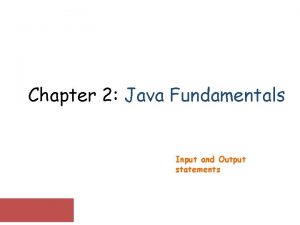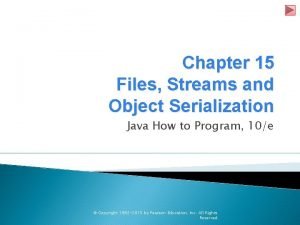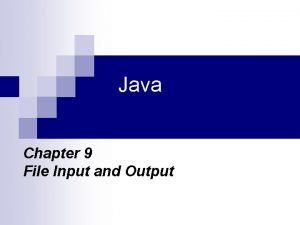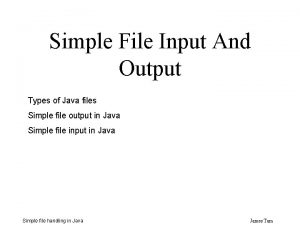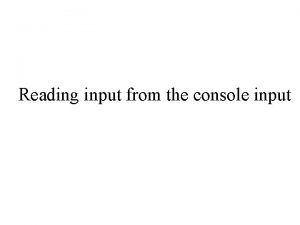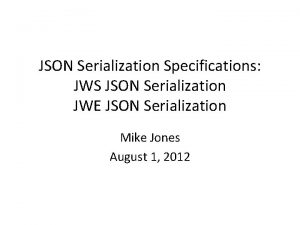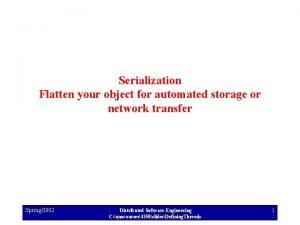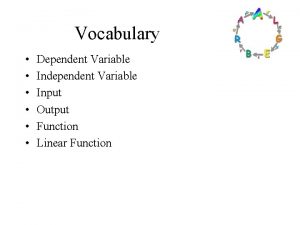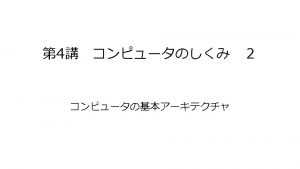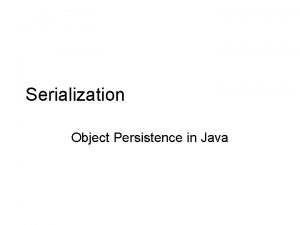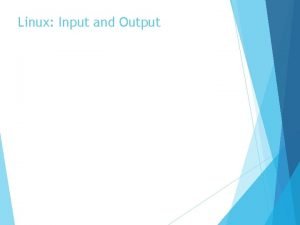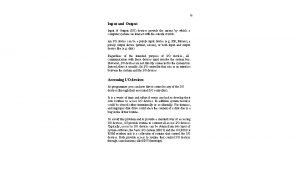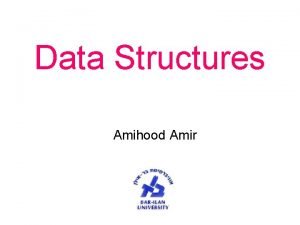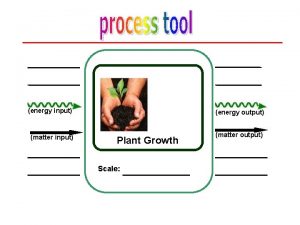OO JAVA PROGRAMMING Input Output SERIALIZATION Serialization is













- Slides: 13

OO JAVA PROGRAMMING Input Output

SERIALIZATION Serialization is the process of writing the state of an object to a byte stream. This is useful when you want to save the state of your program to a persistent storage area, such as a file. At a later time, you may restore these objects by using the process of deserialization.

SERIALIZATION Serialization is also needed to implement Remote Method Invocation (RMI). RMI allows a Java object on one machine to invoke a method of a Java object on a different machine. An object may be supplied as an argument to that remote method. The sending machine serializes the object and deserializes it. transmits it. The receiving machine

SERIALIZATION Assume that an object to be serialized has references to other objects, which, in turn, have references to still more objects. This set of objects and the relationships among them form a directed graph. There may also be circular references within this object graph. That is, object X may contain a reference to object Y, and object Y may contain a reference back to object X. Objects may also contain references to themselves.

SERIALIZATION The object serialization and deserialization facilities have been designed to work correctly in these scenarios. If you attempt to serialize an object at the top of an object graph, all of the other referenced objects are recursively located and serialized. Similarly, during the process of deserialization, all of these objects and their references are correctly restored.

SERIALIZABLE Only an object that implements the Serializable interface can be saved and restored by the serialization facilities. The Serializable interface defines no members. It is simply used to indicate that a class may be serialized. If a class is serializable, all of its subclasses are also serializable. Variables that are declared as transient are not saved by the serialization facilities. Also, static variables are not saved.

EXTERNALIZABLE The Java facilities for serialization and deserialization have been designed so that much of the work to save and restore the state of an object occurs automatically. However, there are cases in which the programmer may need to have control over these processes. For example, it may be desirable to use compression or encryption techniques.

EXTERNALIZABLE The Externalizable interface defines these two methods: void read. External(Object. Input in. Stream) throws IOException, Class. Not. Found. Exception void write. External(Object. Output out. Stream) throws IOException In these methods, in. Stream is the byte stream from which the object is to be read, and out. Stream is the byte stream to which the object is to be written.

RANDOMACCESSFILE Random. Access. File encapsulates a random-access file. It is not derived from Input. Stream or Output. Stream. Instead, it implements the interfaces Data. Input and Data. Output, which define the basic I/O methods. It also supports positioning requests—that is, you can position the file pointer within the file.

RANDOMACCESSFILE Random. Access. File(File file. Obj, String access) throws File. Not. Found. Exception Random. Access. File(String filename, String access) throws File. Not. Found. Exception Random. Access. File implements the standard input and output methods, which you can use to read and write to random access files.

RANDOMACCESSFILE In the first form, file. Obj specifies the name of the file to open as a File object. In the second form, the name of the file is passed in filename. In both cases, access determines what type of file access is permitted. If it is “r”, then the file can be read, but not written. If it is “rw”, then the file is opened in read-write mode.

RANDOMACCESSFILE If it is “rws”, the file is opened for read-write operations and every change to the file’s data or metadata will be immediately written to the physical device. If it is “rwd”, the file is opened for read-write operations and every change to the file’s data will be immediately written to the physical device.

RANDOMACCESSFILE The method seek( ), shown here, is used to set the current position of the file pointer within the file: � void seek(long new. Pos) throws IOException � Here, new. Pos specifies the new position, in bytes, of the file pointer from the beginning of the file. After a call to seek( ), the next read or write operation will occur at the new file position.
 Java input and output statements
Java input and output statements Chapter 15 input output java
Chapter 15 input output java Java file input output
Java file input output Java file input and output
Java file input and output Console input and output in java
Console input and output in java Sncm serialization
Sncm serialization Can't pickle psycopg2.extensions.connection objects
Can't pickle psycopg2.extensions.connection objects Kotlinx serialization generics
Kotlinx serialization generics Hadoop i/o compression and serialization
Hadoop i/o compression and serialization Network serialization
Network serialization Jws json serialization
Jws json serialization Dscsa serialization timeline
Dscsa serialization timeline Kotlinx serialization performance
Kotlinx serialization performance Is the independent variable x
Is the independent variable x
